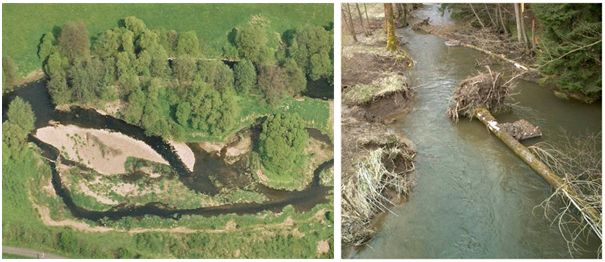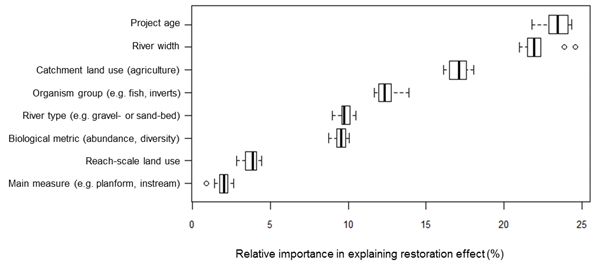One of the main approaches in REFORM is to review existing restoration data to learn from the past and improve river management in the future. An increasing number of rivers have been restored over the past few decades but only a small number of these projects have been monitored, and hence, the knowledge on the effect of river restoration on biota is limited. Nevertheless, the monitoring results of several projects are available. Some narrative reviews have already been published, but a comprehensive quantitative, so-called “meta-analysis”, which summarises the findings of these existing studies was lacking. This meta-analysis took place in REFORM (deliverable 4.2) and aimed at quantifying restoration success; identifying catchment, river reach, and project characteristics which influence (either constrain or enhance) the effect of restoration; and deriving recommendations for river management.

Figure 1: Two typical restoration projects included in the database, focusing on channel planform (left, © A. Lorenz) and instream channel features (right, © W. Klein).
A unique dataset has been compiled, containing 353 entries on the effect of restoration derived from 120 projects. The projects covered a wide range of different river types, river sizes, catchment land use and project age, but most restored reaches were rather short (< 2.6 km) and implemented in the second-last decade (10-90th percentile range 1991-2005). In most projects, multiple measures have been applied to restore instream habitats, channel-planform, the riparian or floodplain area and/or river continuity, whereas sediment, hydrological and flow restoration measures were virtually missing in the dataset (Figure 1).
Although the meta-analysis is the most comprehensive study to date, it was still restricted in two ways. First, the study focused on the effect of restoration on the diversity and abundance of fish, macroinvertebrates and macrophytes, simply because only these biological metrics and organism groups were investigated in a larger number of studies, allowing for a statistical analysis. Second, restoration projects were not intended and designed to be scientific experiments. Therefore, they often applied multiple measures and relatively simple and short-term Control-Impact monitoring schemes (comparison of restored and unrestored reaches), making it difficult to disentangle the effect of single restoration measures and the effect of restoration from general trends in the catchment.
Nevertheless, based on the results and other existing reviews, the following conclusions can be drawn:
- Overall, the effect of hydromorphological restoration on biota is positive but variability is high: Restoration in general has a positive effect on floodplain vegetation, ground beetles, macrophytes, fish and invertebrates.
- Restoration effect differs between organism groups: In general, restoration effect on diversity in the medium-term is highest for terrestrial and semi-aquatic groups like floodplain vegetation and ground beetles, intermediate for macrophytes, lower for fish and lowest for macroinvertebrates. This is especially true for channel-planform measures like re-meandering and widening/re-braiding.
- Restoration has a higher effect on the number of individuals than on the number of taxa: This indicates that, in general, it is easier to increase the number of individuals in the restored reach than establishing new taxa.
- Restoration effect only slightly differs between measures, i.e. there is no single “best” measure: There are no large differences in the overall effect of different measures but there is a tendency that terrestrial and semi-aquatic organism groups like floodplain vegetation, ground beetles and macrophytes benefit most from channel-planform measures and aquatic groups like fish and invertebrates from instream measures.
- Conditions which favour restoration success can be identified but ecological outcome cannot be predicted with great certainty.
- Overall, restoration success most strongly depends on project age, river width, and is affected by agricultural land use: Project age is the most important predictor affecting restoration success (Figure 2), but the direction of the effect of project age on restoration success differs between organism groups (no simple increase of restoration effect with time).

Figure 2: Relative importance of catchment, river reach and project characteristics for restoration success.
In summary, it was possible to draw some initial and important conclusions for river management from the evaluation of hydromorphological restoration based on existing monitoring data. However, monitoring data are still scarce. More robust, practical, relevant and quantitative results (e.g. thresholds) could be derived and river management would benefit from:
- Original monitoring data, which would allow the use of functional metrics to investigate the underlying processes and to infer causal relationships.
- Full before-after-control-impact (BACI) monitoring designs, which most probably would substantially decrease scatter in the datasets and analyses.
- A larger number of monitored projects, which easily could be accomplished since a large number of hydromorphological restoration measures will be implemented in the upcoming years.
- The availability of long-time monitoring data sets to investigate the effect of project age, which was identified as the most important variable affecting restoration success.
- A more intensive exchange and collaboration between river science and river management in planning monitoring programs is strongly recommended. This would offer a great opportunity to make fundamental advances in our understanding of how river restoration affects river hydromorphology and biota and to identify (cost-) effective restoration measures.
The full report “Evaluation of hydromorphological restoration from existing data” is available here.
Author: Jochem Kail (IGB/UDE)
